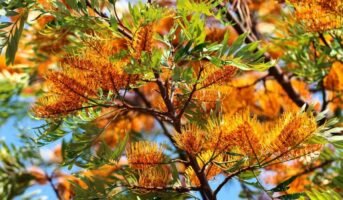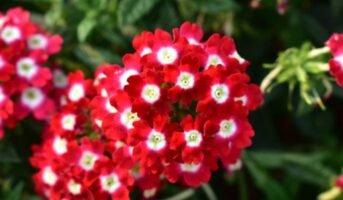The exotically fragrant flowers of Manoranjitham, also known as the climbing ylang-ylang, can be found in regions including India, Burma, southern China, and Taiwan. In addition to the “ylang-ylang vine” and “tail grape,” the manoranjitham flower goes by various names in other nations.
Read through this beginner’s guide to manoranjitham flower cultivation to understand the fundamentals.
See also: Jade plants benefits and how to take care of them
Manoranjitham flower: Key facts
| Plant name (Latin) | Artabotrys hexapetalus |
| Plant family | Annonaceae (custard apple family) |
| Native region | Indonesia, Malaysia, Philippines |
| Growing habit | Trees in tropical regions that produce fragrant yellow flowers nearly all year long. |
| Parts used | Flowers |
| Essential oil extraction technique | Distilling the flower petals in steam |
See Also:Husk of Coconut: All you need to know
Manoranjitham flower: Features

Source: Pinterest
The Manoranjitham flower plant is widely grown in India. It uses hook-like protrusions from its branches to cling to supports and blooms with a light green tint with a strong fragrance and becomes yellow after blossoming. Its enticing aroma may be detected from a very great distance, and it is both more potent and more widespread whenever there is a gust of moist wind.
Known about: What is seed propagation? What are its advantages?
Manoranjitham flower: Planting

Source: Pinterest
Propagating the manoranjitham flower plant through cuttings is more difficult than growing it from seed. Its seeds should be soaked in room temperature water for a half-hour before planting to speed up the process. Then, they should be planted 1/8 inch deep in mildly acidic and high-quality potting soil. The soil should be kept damp until the seedlings emerge. The process of germination is rather slow.
Pick a place that gets plenty of sunlight from the south; it can also grow in partial shade, but the flowers will be smaller. Wait to water it until the soil’s top inch or two is completely dry. A tropical plant’s fragrant blossoms are enhanced by high humidity. Whether in a greenhouse or other humid environment, it blooms continuously and flourishes throughout the year.
see also about: cannonball tree
Manoranjitham flower: Plant care
It is a plant that is native to rainforests and may grow to a height of ten to twelve metres. Since it is a very tall plant, it must be regularly pruned to keep its form. If you live in an area that experiences a lot of wind, you should plant it in front of a structure or a tree since its wood is slender and not very thick, and it has the potential to break off in severe gusts. Once it is fully grown and established, the manoranjitham flower plant is immune to diseases and produces flowers continuously throughout the year.
Manoranjitham flower: How to grow
Cananga fruticosa is a dwarf type of manoranjitham flower plant that grows well in containers. Although it may reach a height of 3–5 m without Pruning, it makes an excellent container plant if you do. Its blossoms will not be as fragrant as those of larger varieties, but they are ideal for those with little room. Increase the humidity by placing a tray of stones and water.
Manoranjitham flower: Reasons for growing manoranjitham flower
According to legends preserved in ancient Indo-Malayan texts, the manoranjitham flower is thought to have the power to improve one’s mood and make one live longer just by smelling them.
- In addition to the ancient rumours, its odour is extremely good. It is a blend of custard apple and jasmine and smells very soft and sweet.
- Hummingbirds, butterflies, and bees are just a few of the natural pollinators drawn to this plant’s blossoms.
- When used topically for wounds, the pulverised leaves of this plant promote healing.
Medicinal uses of manoranjitham flower oil
Manoranjitham flower oil is exquisitely fragrant, sweet, and rich and calms nerves. It’s helpful in stressful situations since it slows down our pulse rate and respiration. You may either like or despise the smell of this oil, but for those that do, it may be immensely comforting and reassuring.
With its unique fragrance, this natural antidepressant is guaranteed to brighten your cold days. Take caution since manoranjitham flower oil might induce headaches if taken improperly.
Manoranjitham flower: Side effects
Many people are allergic to parts of manoranjitham flower, including the phenolic compound isoeugenol. Putting it on your skin might cause irritation and even contact dermatitis. Do not apply pure manoranjitham flower oil to your skin; this goes for all essential oils. If you’re planning on using this oil on a significant area of your body, face, or scalp, first dilute it and do a skin patch test.
Both dogs and cats should avoid consuming manoranjitham flower since it is toxic. You should never rub manoranjitham flower oil into your pet’s skin, claws, or coat, and you should also avoid using it in areas where your pet may potentially lick or breathe it in.
FAQs
What use does the manoranjitham flower serve?
Manoranjitham's flowers are used to cure nausea, diarrhoea, vomiting, stomachache, blood and heart problems, itching, sweating, bad breath, thirst, and headaches.
What is the English name for the plant Manoranjitham?
Once mature, how does manoranjitham appear?
Obviously, the flower is the most notable part of the plant. Each leaf node on a developing Manoranjitham branch has a solitary bloom. It lacks vivid hues and instead resembles leaves in their light green at peak bloom and gradual yellowing as it ages.
Housing News Desk is the news desk of leading online real estate portal, Housing.com. Housing News Desk focuses on a variety of topics such as real estate laws, taxes, current news, property trends, home loans, rentals, décor, green homes, home improvement, etc. The main objective of the news desk, is to cover the real estate sector from the perspective of providing information that is useful to the end-user.
Facebook: https://www.facebook.com/housing.com/
Twitter: https://twitter.com/Housing
Email: [email protected]











